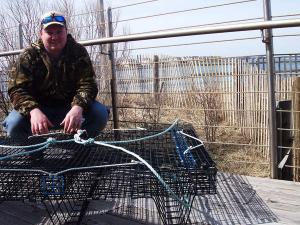Delaware's aquaculture program still under review
Unsightly gear. Navigation problems. Less room for recreation.
These are just a few complaints some Inland Bays residents have raised in their opposition to Delaware's proposed commercial shellfish aquaculture program, and they hope the U.S. Army Corps of Engineers takes their concerns into consideration.
Cape Region residents living along Little Assawoman Bay and Beach Cove in Indian River Bay began protesting the state's proposed aquaculture program in the fall, taking issue with the Department of Natural Resources and Environmental Control's public process and site selection for aquaculture leasing areas.
Corps spokesman Richard Pearsall said the corps is reviewing more than 300 letters and emails received during a 30-day public comment period that ended Feb. 23. The corps has yet to decide whether it will hold a public hearing, he said, although one has been requested.
Delaware has proposed eight shellfish aquaculture development areas, or SADAs, within the Inland Bays. The corps is considering the program for a regional provision to a nationwide permit; if granted, the regional provision would streamline and expedite individual leases.
Opponents have honed in on specific leasing areas in Little Assawoman Bay and Beach Cove in Indian River Bay. Delaware's aquaculture program has identified 442 one-acre plots in the Inland Bays, with 118 leasable acres in Little Assawoman, 115 acres in Indian River and 209 acres in Rehoboth Bay for the harvesting of American eastern oysters. The harvest of hard clams will be permitted only in Little Assawoman Bay.
Residents say notice insufficient
Residents have argued DNREC failed to properly notify nearby homeowners of the specific lease sites, working hours and gear could cause disturbances, studies did not fully consider potential effects on navigation, and that commercial aquaculture – specifically in Little Assawoman Bay and Beach Cove – will destroy recreational opportunities for locals and tourists.
“Beach Cove is a modest Inland Bay on which, for generations, a substantial number of owners, visitors, renters and tourists rely for unencumbered recreational pursuits,” wrote Steve Plotkin, of Bethany Beach, in a letter to the corps. “Commercial aquaculture is inherently incompatible with prior recreational uses.”
Ocean View resident Steve Callanen agrees with Plotkin's sentiments, especially considering the dense residential population along the Inland Bays, he said.
Callanen submitted two letters to the corps – including a 20-page argument with photos and additional documents. In his letter, he argues local homeowners lacked representation on the Tiger Team, a group of stakeholders that helped develop Delaware's aquaculture program led by representatives from the Delaware Center for the Inland Bays.
“This highly flawed representation on the Tiger Team serves to discredit the entire shellfish aquaculture proposal process,” Callanen wrote. “As a matter of public fairness and equity, this blatant Tiger Team oversight needs to be recognized and cited as a primary reason for disallowing DNREC's shellfish aquaculture proposal.”
Oysters improve water quality
While some oppose aquaculture in the bays, others have already invested in equipment in anticipation of obtaining a lease.
EJ Chalabala, who led the Tiger Team while working as a restoration coordinator at the Delaware Center for the Inland Bays, has since left the center to pursue a full-time waterman career, including shellfish aquaculture. He said aquaculture in the Inland Bays is a win-win because it will create a new industry, with new jobs and economic growth, as well as cleaning up the bays.
“This will put oysters that filter 30 to 50 gallons per day per oyster in the bays, and there will be upwards of 250,000 oysters on one acre,” he said. “Just the water quality benefits are going to be great, especially if we can get a lot of people involved.”
If the corps approves Delaware's proposal, individual farmers would not have to obtain a permit directly from the corps. Still, farmers will go through a lengthy approval process before farming can begin. The process would include a state-approved application, a business and operation plan, testing of sites for clam density, a secured performance bond and liability insurance, survey of boundaries and the marking of corners of each lease site.
Major investment
Chalabala estimated each farmer will invest a minimum $50,000 to get started, not including the costs of insurance and a performance bond. Chalabala said there will be no immediate explosion of aquaculture sites popping up in the bays; it's a big investment, he said, and it will take a few years to see any returns.
“It's a slowly evolving process,” he said. “It took Rhode Island 15 years to get 160 acres to be leased. It's going to take time, but we have to do things like this in order to help our environment, which in turn is going to create jobs for people. It improves the economy and helps the water quality in the Inland Bays.”
If approved, the first leases would be determined by a lottery and will be annually renewable for 15 years. The application fee for a one-acre aquaculture lease is $300, with annual renewal fees for Delaware residents costing an additional $100 per acre. The annual renewal fee for nonresidents is $1,000 per acre. Farmers will be able to lease one to five acres in Rehoboth and Indian River bays, and an additional one to five acres in Little Assawoman Bay.
It is unclear when the corps will make a decision on Delaware's proposal. If the corps recommends changing the location of even one acre, it would require a full regulatory review, which could take an additional year or more. For more information about Delaware's aquaculture program, go to www.dnrec.delaware.gov/fw/Fisheries/Pages/ShellfishAquaculture.aspx.
Aquaculture regulations a two-year process
The Delaware Center for the Inland Bays created the Tiger Team in March 2012, including representatives from the center, DNREC, Department of Agriculture, University of Delaware Sea Grant, Sussex County Economic Development, Delaware Shellfish Advisory Council, University of Maryland Extension Service, recreation interests, commercial clammers and fisherman.
For more than a year, the team held public meetings to explore various factors, including depth, native clam populations, salinity, water use, current shellfish harvesting and fishing locations, navigational channels, distance to shoreline and water quality, to develop recommended lease areas.
The Tiger Team's efforts to develop shellfish aquaculture regulations became official in August 2013. That's when Gov. Jack Markell signed House Bill 160, creating a commercial shellfish aquaculture industry in Delaware's Inland Bays and made Delaware the last state on the East Coast to adopt aquaculture legislation.
Delaware's aquaculture regulations went into effect Aug. 11, 2014, following two public workshops and a public hearing, in addition to more than a dozen public meetings hosted by the Tiger Team.




























































